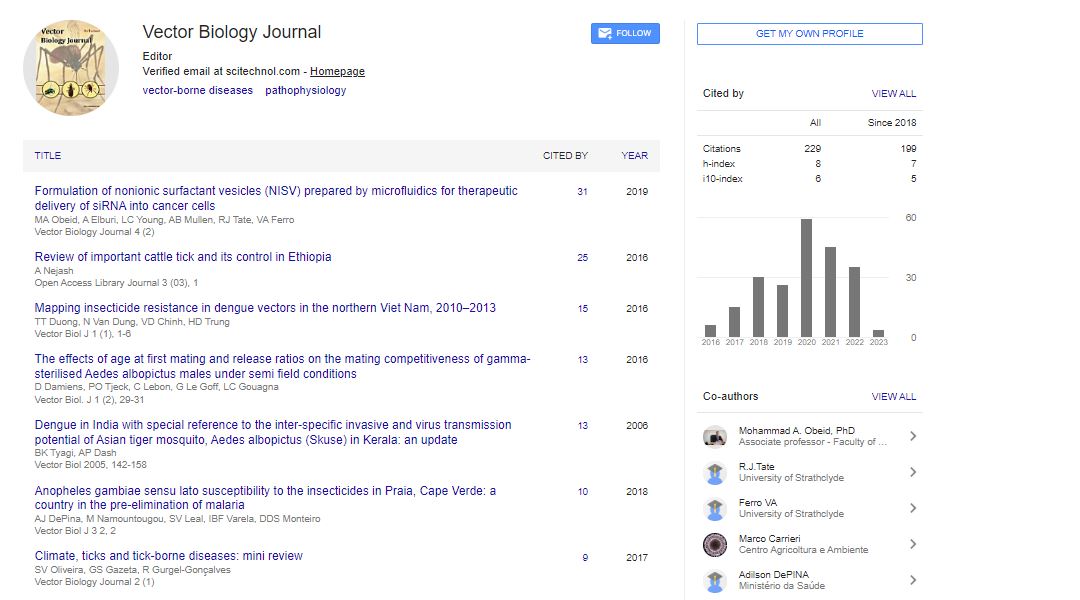Opinion Article, Vector Biol J Vol: 8 Issue: 4
Vector Competence: The Function of Vectors in Disease Transmission
Yurayart Thontira*
1Department of Infectious diseases, Kasetsart University, Bangkok, Thailand
*Corresponding Author: Yurayart Thontira,
Department of Infectious diseases,
Kasetsart University, Bangkok, Thailand
E-mail: thontira.yur@gmail.com
Received date: 21 November, 2023, Manuscript No. VBJ-24-127985;
Editor assigned date: 23 November, 2023, PreQC No. VBJ-24-127985 (PQ);
Reviewed date: 07 December, 2023, QC No. VBJ-24-127985;
Revised date: 15 December, 2023, Manuscript No. VBJ-24-127985 (R);
Published date: 22 December, 2023, DOI: 10.4172/2473-4810.1000279.
Citation: Thontira y (2023) Vector Competence: The Function of Vectors in Disease Transmission. Vector Biol J 8:4.
Description
Vector competence is an essential concept in the field of vectorborne diseases, removal illumination on the ability of arthropod vectors to acquire, maintain, and transmit pathogens to susceptible hosts. It serves as an important determinant of the transmission dynamics and epidemiology of various infectious diseases, including malaria, dengue fever, Zika virus, and Lyme disease.
Vector competence refers to the fundamental ability of vector organisms to become infected with a pathogen, support its replication or development, and subsequently transmit it to a susceptible host during blood feeding. It is influenced by complex interactions between the vector, the pathogen, and the environment, eventually affecting transmission dynamics of vector-borne diseases.
Mechanisms of vector competence
Vector competence is influenced by a multitude of factors; including vector genetics, vector immune responses, pathogen genetics, and environmental conditions. At the molecular level, interactions between the vector and the pathogen determine the outcome of infection, including successful establishment, replication, and dissemination within the vector.
Important mechanisms involved in vector competence include:
Midgut infection: Pathogens ingested during blood feeding must overcome the physical and immune barriers of the vector's midgut to establish infection. Successful traversal of the midgut epithelium allows the pathogen to enter the hemocoel and disseminate to other tissues.
Escape from midgut escape barrier: Some pathogens encounter a midgut escape barrier, where they are eliminated or inhibited within the midgut epithelium. Pathogens capable of avoiding this barrier through mechanisms such as receptor-mediated endocytosis or modulation of vector immune responses can establish successful infections.
Dissemination and transmission: Once inside the vector, pathogens must disseminate to other tissues, including the salivary glands, where they can be transmitted to a new host during subsequent blood feeding. Efficient dissemination and transmission require interactions between the pathogen and vector tissues, as well as evasion of vector immune responses.
Factors influencing vector competence
Vector competence is influenced by a wide range of intrinsic and extrinsic factors, including:
Vector species: Different vector species exhibit varying levels of competence for specific pathogens. Factors such as vector physiology, behavior, and immune responses contribute to species-specific differences in vector competence.
Vector genetics: Genetic variability within vector populations can influence susceptibility to infection, as well as the ability to transmit pathogens. Genetic factors may impact vector immune responses, midgut barrier function, and interactions with pathogens.
Pathogen strain: Variability in pathogen strains can affect vector competence by altering interactions with vector tissues, evasion of vector immune responses, and replication kinetics within the vector.
Environmental conditions: Environmental factors such as temperature, humidity, and habitat suitability can influence vector competence by affecting vector physiology, vector-pathogen interactions, and the abundance of vector populations.
Applications and implications
Understanding the factors influencing vector competence has important implications for disease control and prevention:
Targeted vector control: Knowledge of vector competence can inform targeted vector control interventions aimed at reducing populations of competent vectors or disrupting transmission cycles. Techniques such as insecticide-treated bed nets, indoor residual spraying, and larval source reduction can effectively reduce vector populations and mitigate disease transmission.
Disease surveillance: Monitoring vector competence can helps in disease surveillance efforts by identifying high-risk areas for pathogen transmission and detecting emerging threats. Surveillance data can guide public health interventions and resource allocation to prevent and control outbreaks.
Vaccine and drug development: Insights into vector competence can inform the development of vaccines and therapeutics targeting specific levels of the pathogen life cycle within the vector. By understanding the molecular mechanisms underlying vector-pathogen interactions, researchers can identify potential targets for intervention and control.
 Spanish
Spanish  Chinese
Chinese  Russian
Russian  German
German  French
French  Japanese
Japanese  Portuguese
Portuguese  Hindi
Hindi 